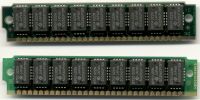Difference between revisions of "Single Inline Memory Module"
From Computer History Wiki
m (Typo: then -> than) |
m (+cat) |
||
| (4 intermediate revisions by 2 users not shown) | |||
| Line 1: | Line 1: | ||
| − | + | [[Image:30 pin simm.jpg|thumb|right|200px|Two 30pin SIMMs]] | |
| − | These memory chips came on a small | + | A '''Single Inline Memory Module''' (usually abbreviated to '''SIMM''') was a standard [[main memory]] technology in the early [[Pentium]] era. |
| + | |||
| + | These memory chips came on a small [[printed circuit board]] that you would snap in place into a socket. These were far easier to install, remove and upgrade than the old [[DIP]] chips. | ||
SIMMs were typically known for how many pins they had, with the common types being 30 pin & 72pin SIMMs. | SIMMs were typically known for how many pins they had, with the common types being 30 pin & 72pin SIMMs. | ||
| − | + | {{semi-stub}} | |
| − | + | [[Category: Components]] | |
Latest revision as of 01:43, 20 December 2018
A Single Inline Memory Module (usually abbreviated to SIMM) was a standard main memory technology in the early Pentium era.
These memory chips came on a small printed circuit board that you would snap in place into a socket. These were far easier to install, remove and upgrade than the old DIP chips.
SIMMs were typically known for how many pins they had, with the common types being 30 pin & 72pin SIMMs.
